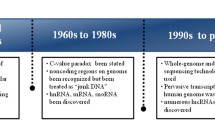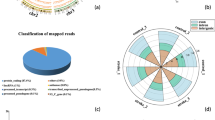Abstract
Nowadays, similar strategies have been used for the treatment and prevention of acute stroke in both diabetes mellitus (DM) and non-DM populations. These strategies were analyzed to provide an experimental basis for the clinical prevention and treatment of stroke in patients both with and without DM. Tree shrews were randomly divided into control, DM, ischemic stroke (IS), and DMIS groups with 18 animals in each group. Serum biochemical indicators were used to assess metabolic status. Neural tissue damage was determined using triphenyl tetrazolium chloride staining, H-E staining, and electron microscopy. Differential gene expression of neural tissue between the DM and control groups and the IS and DMIS groups was measured using RNA-seq analysis. The serum glucose levels of the DM and DMIS groups were significantly higher than other groups. In the DMIS group, the infarct size was significantly larger than in the IS group (19.56 ± 1.25%), with a more obvious abnormal ultrastructure of neural cells. RNA-seq analysis showed that the expression of IL-8, C–C motif chemokine 2 (CCL2), and alpha-1-antichymotrypsin was significantly higher in the DM group than in the control group. The CCL7, ATP-binding cassette sub-family A member 12, and adhesion G protein-coupled receptor E2 levels were significantly higher in the DMIS group than in the IS group. For the prevention and treatment of stroke in patients with DM, reducing the inflammatory state of the nervous system may reduce the incidence of stroke and improve the prognosis of neurological function after IS.






Similar content being viewed by others
Data availability
The datasets generated during and/or analysed during the current study are available from the corresponding author on reasonable request.
Code availability
Not applicable.
References
Arac A, Grimbaldeston MA, Nepomuceno AR, Olayiwola O, Pereira MP, Nishiyama Y et al (2014) Evidence that meningeal mast cells can worsen stroke pathology in mice. Am J Pathol 184(9):2493–2504
Bai B, Li D, Xue G, Feng P, Wang M, Han Y et al (2021) The novel GLP-1/GIP dual agonist DA3-CH is more effective than liraglutide in reducing endoplasmic reticulum stress in diabetic rats with cerebral ischemia-reperfusion injury. Nutr Metab Cardiovasc Dis 31(1):333–343
Beckman JA, Paneni F, Cosentino F, Creager MA (2013) Diabetes and vascular disease: pathophysiology, clinical consequences, and medical therapy: part II. Eur Heart J 34(31):2444–2452
Bhalla A, Wang Y, Rudd A, Wolfe CD (2013) Differences in outcome and predictors between ischemic and intracerebral hemorrhage: the South London Stroke Register. Stroke 44(8):2174–2181
Bruno A, Liebeskind D, Hao Q, Raychev R, Investigators US (2010) Diabetes mellitus, acute hyperglycemia, and ischemic stroke. Curr Treat Options Neurol 12(6):492–503
Collaborators GBDS (2019) Global, regional, and national burden of stroke, 1990–2016: a systematic analysis for the global burden of disease study 2016. Lancet Neurol 18(5):439–458
He Q, Shi X, Zhou B, Teng J, Zhang C, Liu S et al (2018) Interleukin 8 (CXCL8)-CXC chemokine receptor 2 (CXCR2) axis contributes to MiR-4437-associated recruitment of granulocytes and natural killer cells in ischemic stroke. Mol Immunol 101:440–449
Hill MD (2014) Stroke and diabetes mellitus. Handb Clin Neurol 126:167–174
Hong P, Gu RN, Li FX, Xiong XX, Liang WB, You ZJ et al (2019) NLRP3 inflammasome as a potential treatment in ischemic stroke concomitant with diabetes. J Neuroinflammation 16(1):121
Jenny NS, Callas PW, Judd SE, McClure LA, Kissela B, Zakai NA et al (2019) Inflammatory cytokines and ischemic stroke risk: the regards cohort. Neurology 92(20):e2375–e2384
Jiang Y, Liu N, Wang Q, Yu Z, Lin L, Yuan J et al (2018) Endocrine regulator rFGF21 (recombinant human fibroblast growth factor 21) improves neurological outcomes following focal ischemic stroke of type 2 diabetes mellitus male mice. Stroke 49(12):3039–3049
Kaas JH, Gharbawie OA, Stepniewska I (2013) Cortical networks for ethologically relevant behaviors in primates. Am J Primatol 75(5):407–414
Kruyt ND, Biessels GJ, Devries JH, Roos YB (2010) Hyperglycemia in acute ischemic stroke: pathophysiology and clinical management. Nat Rev Neurol 6(3):145–155
Lau LH, Lew J, Borschmann K, Thijs V, Ekinci EI (2019) Prevalence of diabetes and its effects on stroke outcomes: a meta-analysis and literature review. J Diabetes Investig 10(3):780–792
Li J, Quan K, Wang Y, Zhao X, Li Z, Pan Y et al (2020) Effect of stress hyperglycemia on neurological deficit and mortality in the acute ischemic stroke people with and without diabetes. Front Neurol 11(1):e576895
Liu P, Liu S, Feng N, Wang Y, Gao Y, Wu J (2020) Association between neurological deterioration and outcomes in patients with stroke. Ann Transl Med 8(1):4
Lv H, Li J, Che YQ (2019) CXCL8 gene silencing promotes neuroglial cells activation while inhibiting neuroinflammation through the PI3K/Akt/NF-kappaB-signaling pathway in mice with ischemic stroke. J Cell Physiol 234(5):7341–7355
Ma S, Wang J, Wang Y, Dai X, Xu F, Gao X et al (2018) Diabetes mellitus impairs white matter repair and long-term functional deficits after cerebral ischemia. Stroke 49(10):2453–2463
Mitome-Mishima Y, Miyamoto N, Tanaka R, Shimosawa T, Oishi H, Arai H et al (2014) Adrenomedullin deficiency and aging exacerbate ischemic white matter injury after prolonged cerebral hypoperfusion in mice. Biomed Res Int 2014:861632
Pintana H, Lietzau G, Augestad IL, Chiazza F, Nystrom T, Patrone C et al (2019) Obesity-induced type 2 diabetes impairs neurological recovery after stroke in correlation with decreased neurogenesis and persistent atrophy of parvalbumin-positive interneurons. Clin Sci (lond) 133(13):1367–1386
Romero JR, Morris J, Pikula A (2008) Stroke prevention: modifying risk factors. Ther Adv Cardiovasc Dis 2(4):287–303
Shishkova VN, Adasheva TV, Remenik AY, Valyaeva VN, Shklovsky VM (2018) Prognostic significance of clinical-anthropometric, biochemical, metabolic, vascular-inflammatory and molecular-genetic markers in the development of the first ischemic stroke. Zh Nevrol Psikhiatr Im S S Korsakova 118(2):4–11
Shou J, Zhou L, Zhu S, Zhang X (2015) Diabetes is an independent risk factor for stroke recurrence in stroke patients: a meta-analysis. J Stroke Cerebrovasc Dis 24(9):1961–1968
Venkat P, Yan T, Chopp M, Zacharek A, Ning R, Van Slyke P et al (2018) Angiopoietin-1 mimetic peptide promotes neuroprotection after stroke in type 1 diabetic rats. Cell Transplant 27(12):1744–1752
Wen L, Zhang S, Wan K, Zhang H, Zhang X (2020) Risk factors of haemorrhagic transformation for acute ischaemic stroke in Chinese patients receiving intravenous thrombolysis: a meta-analysis. Medicine (Baltimore) 99(7):e18995
Yuan C, Chen S, Ruan Y, Liu Y, Cheng H, Zeng Y et al (2021) The stress hyperglycemia ratio is associated with hemorrhagic transformation in patients with acute ischemic stroke. Clin Interv Aging 16(1):431–442
Zhang CR, Yu ZC, Li SQ (2017) Mechanism of ischemic postconditioning relieved brain edema and cerebral infarction after cerebral ischemia in tree shrews. Acta Anatomica Sinica 48(2):135–141
Zhang S, An Q, Wang T, Gao S, Zhou G (2018) Autophagy- and MMP-2/9-mediated reduction and redistribution of ZO-1 contribute to hyperglycemia-increased blood-brain barrier permeability during early reperfusion in stroke. Neuroscience 377(1):126–137
Zhao L, Tan SF, Ke TY, Li SQ (2019) Regulation of ischemic postconditioning on metabolic disorders of type 2 diabetes mellitus combined with cerebral ischemia in tree shrews. China Med Abstr (Int Med) 35(1):58–66
Zuloaga KL, Krasnow SM, Zhu X, Zhang W, Jouihan SA, Shangraw RE et al (2014) Mechanism of protection by soluble epoxide hydrolase inhibition in type 2 diabetic stroke. PLoS One 9(5):e97529
Acknowledgements
Thank Professor Jiejie Dai’s laboratory. Thank Yuanyuan Han for providing suggestions and instructions in the process of modelling. Thank Ying Tang for helping us review pathology materials.
Funding
This work was supported by grants from National Science Fund subsidized project (Grant No. 81760327), Yunnan Province Young and Middle-aged Academic and Technical Leaders Reserve Talents Training Project (Grant No. 2017HB049), Yunnan high-level health and family planning technical personnel training project (Grant No. H-2017043), Yunnan Provincial Department of Science and Technology—Kunming Medical Joint Project (Grant No. 2018FE001(-228)), Kunming Medical University Second Affiliated Hospital Talent Training Program (Grant No. RCPYXM2017-3–16), Research Institutions Program in Yunnan medical and health units (Grant No. 2018NS0293). Kunming Medical University Education Research and Reform Program (Grant No. 2020-JY-Y-085). The funders had no role in study design, data collection and analysis, decision to publish, or preparation of the manuscript.
Author information
Authors and Affiliations
Contributions
Ling Zhao and Tingyu Ke: study concept and design, analysis and interpretation of data, drafting of the manuscript, funding acquisition. Ling Zhao, Shiying Huang, and Qiwei Liao: the acquisition of samples or data, statistical analysis, review of the manuscript. Ling Zhao, Xia Li, Shufen Tan, and Shuqing Li: statistical analysis, review of the manuscript, material supports.
Corresponding authors
Ethics declarations
Conflicts of interest
The authors have no relevant financial or non-financial interests to disclose.
Additional information
Publisher’s note
Springer Nature remains neutral with regard to jurisdictional claims in published maps and institutional affiliations.
Supplementary Information
Below is the link to the electronic supplementary material.
Rights and permissions
About this article
Cite this article
Zhao, L., Huang, S., Liao, Q. et al. RNA-seq analysis of ischemia stroke and normal brain in a tree shrew model with or without type 2 diabetes mellitus. Metab Brain Dis 36, 1889–1901 (2021). https://doi.org/10.1007/s11011-021-00813-5
Received:
Accepted:
Published:
Issue Date:
DOI: https://doi.org/10.1007/s11011-021-00813-5




